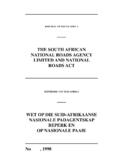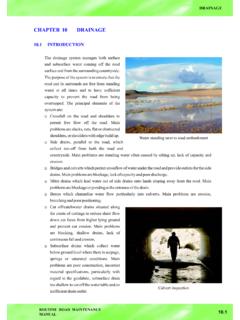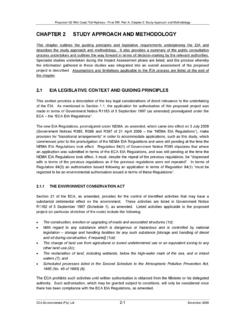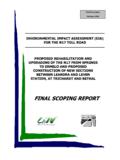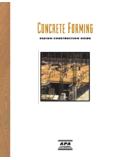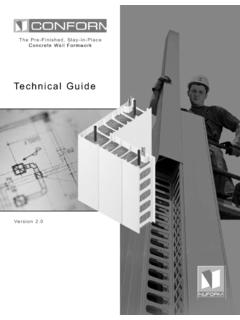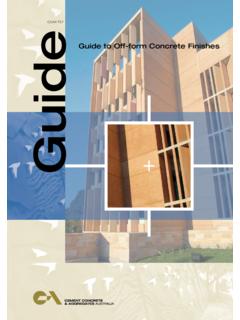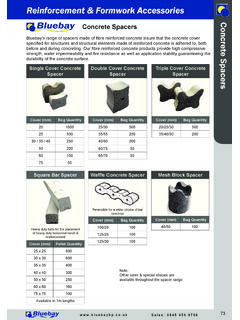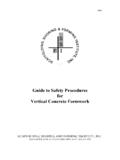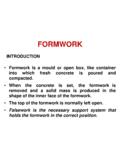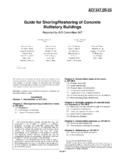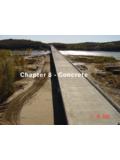Transcription of CHAPTER 6 - FALSEWORK, FORMWORK AND …
1 falsework , FORMWORK and concrete finish 6-1 CHAPTER 6 - falsework , FORMWORK AND concrete finish DS Temple SCOPE This section covers the inspection and monitoring of falsework , FORMWORK and concrete finish as per the applicable CHAPTER of the Specifications. It also includes special attention which must be given to materials used, design and erection of falsework and FORMWORK to be checked by the engineer s monitoring staff. MATERIALS The engineer s monitoring staff should confirm the suitability of proposed materials: falsework Steel Grade to be provided in accordance to Design Requirements. Timber Grade to be provided in accordance to Design Requirements. Condition of all materials to be used should be checked by the engineer s monitoring staff to ensure that the materials are fit for purpose. FORMWORK The most commonly used materials for the manufacture of FORMWORK are steel and timber. The monitoring staff should ensure that the surfaces of forms are clean and free of defects to ensure that the required surface finishes can be obtained.
2 In order to obtain a good quality finish in accordance with the specifications, high quality materials must be used and attention to details and workmanship cannot be over-emphasized. DESIGN The monitoring staff should ensure that the contractor submits (within the period specified in the Project Specification) designs, drawings and calculations where required, for all falsework and FORMWORK for review by the engineer. The design of all temporary works should be undertaken by the contractor, and the engineer through his representatives on site should only scrutinize the plans and pass comment on issues that may be non-compliant in terms of the specifications. No approval should be given for any temporary works as this could attract liability to both the employer and the engineer. Copies of all falsework and FORMWORK designs should be placed on the safety file on site prior to the work being carried out. The following matters should receive attention: falsework , FORMWORK and concrete finish 6-2 falsework Foundations Allowable bearing capacity of founding material for falsework supports to be confirmed by the contractor (Dynamic Cone Penetrometer or other suitable means).
3 Allowance should be made for the wetting of the foundation material when determining the allowable bearing capacity of the founding material. Actual design bearing pressure for falsework supports to be provided by the contractor. Ensure all falsework for the erection of decks and slabs is provided with jacks for adjustment for line and level. For river bridges the stability of foundations under minor flood events should be considered. falsework should always rest on sound founding material which is properly compacted and leveled to ensure no standing water will occur during rain. The adequacy of safety of the falsework should be signed off by the CCP. Load Capacity The load capacity and technical specifications of all elements making up the falsework including jacks, clamps and fittings should be provided with temporary works design. Ensure jack extension limits specified by the manufacturer of the particular type of jack in use are not exceeded.
4 Settlements The contractor should provide with his calculations the expected settlements of the falsework due to elastic deformation of the founding material and falsework . Deflections Levels for the construction of falsework for the construction of slabs and decks should allow for precambering for expected long term/creep deflections due to dead loads, prestressing and superimposed dead loads. This provision should be in accordance with the design drawings and is especially important for very skew reinforced concrete decks. The monitoring staff should liaise with the design office to confirm requirements, and in instances where no precamber is specified, should ensure that this is confirmed by the designer. Reinforced concrete The total deflection can normally be assumed to be 3 times the elastic deflection under Dead and Superimposed Dead Loads. Prestressed concrete The monitoring staff should note that the precambering for prestressed concrete decks could be negative (in downward direction).
5 The long-term deflection in prestressed concrete decks will generally continue in the direction of the initial deflection. Overall Stability and Bracing The monitoring staff should ensure that the contractor s design deals adequately with the overall stability and bracing of the proposed falsework taking into account wind loading and other horizontal actions as required. falsework , FORMWORK and concrete finish 6-3 Photo : Well designed falsework and bracing Temporary Works Vertical and Horizontal Clearance The minimum vertical and horizontal clearances as prescribed by the roads authority and employer should be adhered to by the contractor in his preparation of the temporary works design to be carried out by the contractor. Generally the clearances as specified in the SANRAL Code of Procedure for the Planning and Design of Highway and Road Structures in South Africa should be used. However, where these clearances cannot be achieved the monitoring staff should refer to the engineer for final verification.
6 Temporary guardrails, concrete barriers and other protection should be used to protect the temporary support work. FORMWORK Load Capacity The proposed FORMWORK should be capable of sustaining the loads due to wet concrete and superimposed loads due to construction activities and equipment without excessive deflection. Deflection The engineer s monitoring staff should ensure that the expected deflection of the forms as provided in the FORMWORK design falls within the specified tolerances for surface regularity. Grout Seals Grout seals should be incorporated into the joints between individual FORMWORK panels in all instances where the panels do not fit together with sufficient tightness to prevent leakage of fines. falsework , FORMWORK and concrete finish 6-4 Permanent FORMWORK On beam and slab decks using permanent FORMWORK special attention should be given to bearing length. All permanent FORMWORK should be designed to carry the loads resulting from the wet concrete and superimposed loads due to construction activities and equipment.
7 The deflection under permanent loading should not exceed 50% of the construction tolerance. The strength and bracing of circular void formers should be sufficient to prevent distortion and resist all the loads they will be subjected to, and must comply with the requirements of the drawings and Specifications. The adequacy of the formers and bracing should be signed off by the CCP. Void formers must be tied down to the FORMWORK bearers and should not be tied to or be supported on the reinforcement. In voided deck slabs the concrete should be cast in layers to reduce the effects of buoyancy and to reduce the movement of void formers. Photo : Precast concrete permanent FORMWORK in position before casting. falsework , FORMWORK and concrete finish 6-5 Figure : Bracing and installation of void formers Stripping Minimum stripping times for falsework and FORMWORK must be in accordance with the Specifications. Any deviation in stripping times should be approved by the engineer.
8 INSPECTION The engineer s monitoring staff should inspect the falsework and FORMWORK at the completion of erection and prior to the placing of concrete , and should insure that the CCP has signed off before concreting. The concrete finish should be inspected on final completion of each structural element (Refer to CHAPTER 8). falsework (a) Confirm compliance with the design. (b) Setting out - This is a very important aspect as it is fundamental to successful construction of the structure. (c) Safe access - Should be inspected regularly as a part of the ongoing Site Safety. (d) Foundations - Foundation conditions should be inspected before erection of falsework . All falsework should be inspected as soon as possible after inclement weather or flood event. (e) Support elements - Should be inspected on completion of erection. Special attention should be given to connections, details and areas of transfer of stress and the provision of adequate bracing in accordance with the design.
9 These should include the clamping of bracing and the safe reach of screw jacks. (f) Line and level - Alignment and levels should be in accordance with the contractor s design. (g) falsework should be maintained in position for the times as prescribed in the specifications. Back propping after early removal of falsework should not be permitted. WARNING Inadequately braced void formers may collapse resulting in deck cross sections which do not conform to the design. This is likely to require demolition and reconstruction of the deck. falsework , FORMWORK and concrete finish 6-6 (h) When the concrete is placed in the forms special care must be taken to ensure that no overloading of the FORMWORK or falsework takes place due to the dumping of large piles of concrete in one particular position. FORMWORK (a) Confirm compliance with design requirements as specified on the drawings and specifications. (b) Setting out, line and level to be confirmed.
10 (c) Condition of forms - Ensure forms are fit for purpose, sealed around edges where required and shutter release agent applied prior to fixing of reinforcement. (d) Workmanship of shuttered areas (especially with reference to gaps where grout leakage may occur). (e) Where high quality surface finishes are required F2 and F3, the use of grout seals is recommended. (f) Permanent FORMWORK - Confirm adequate support especially with regard to the holding down and bracing of circular voids. (g) Removal of FORMWORK - Ensure methods for removal of FORMWORK are such that no damage occurs to the freshly cast concrete . (h) Chamfers on exposed surfaces should be formed using new materials and be adequately secured in position during concreting. (i) Kickers should be formed and cast monolithically with foundation concrete . Height to be between 75 and 100mm. The kickers should be of the class of concrete of the element above.

